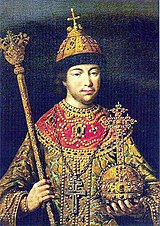
Crown jewels are the objects of metalwork and jewellery in the regalia of a current or former monarchy. They are often used for the coronation of a monarch and a few other ceremonial occasions. A monarch may often be shown wearing them in portraits, as they symbolize the power and continuity of the monarchy. Additions to them may be made, but, since medieval times, the existing items have been typically passed down unchanged, symbolizing the continuity of a monarchy.

The Crown Jewels of the United Kingdom, originally the Crown Jewels of England, are a collection of royal ceremonial objects kept in the Jewel House at the Tower of London, which include the coronation regalia and vestments worn by British monarchs.
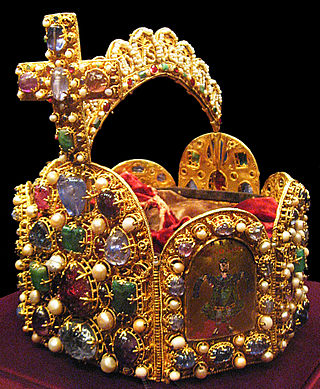
The Imperial Crown of the Holy Roman Empire, a hoop crown with a characteristic octagonal shape, was the coronation crown of the Holy Roman Emperor, probably from the late 10th century until the dissolution of the Holy Roman Empire in 1806. The crown was used in the coronation of the King of the Romans, the title assumed by the Emperor-elect immediately after his election. It is now kept in the Imperial Treasury at the Hofburg in Vienna, Austria.

The French Crown Jewels and Regalia comprise the crowns, orb, sceptres, diadems and jewels that were symbols of Royal or Imperial power between 752 and 1870. These were worn by many Kings and Queens of France as well as Emperor Napoleon. The set was finally broken up, with most of it sold off in 1885 by the Third Republic. The surviving French Crown Jewels, principally a set of historic crowns, diadems and parures, are mainly on display in the Galerie d'Apollon of the Louvre, France's premier museum and former royal palace, together with the Regent Diamond, the Sancy Diamond and the 105-carat (21.0 g) Côte-de-Bretagne red spinel, carved into the form of a dragon. In addition, some gemstones and jewels are on display in the Treasury vault of the Mineralogy gallery in the National Museum of Natural History.
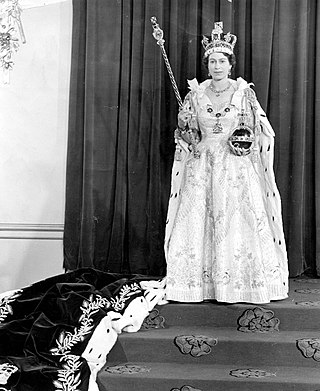
Regalia is the set of emblems, symbols, or paraphernalia indicative of royal status, as well as rights, prerogatives and privileges enjoyed by a sovereign, regardless of title. The word originally referred to the elaborate formal dress and accessories of a sovereign, but now it also refers to any type of elaborate formal dress. The word stems from the Latin substantivation of the adjective regalis, "regal", itself from rex, "king". It is sometimes used in the singular, regale.

The Austrian Crown Jewels are the regalia and vestments worn by the Holy Roman Emperor, and later by the Emperor of Austria, during the coronation ceremony and other state functions. The term refers to the following objects: the crowns, sceptres, orbs, swords, rings, crosses, holy relics and royal robes, as well as several other objects connected with the ceremony. The collection dates from the 10th to the 19th centuries, and it reflects more than a thousand years of European history. It is kept in the Imperial Treasury at the Hofburg Palace in Vienna, Austria.

Danish Crown Regalia are the symbols of the Danish monarchy. They consist of three crowns, a sceptre, globus cruciger, the sword of state and an ampulla . The Danish Royal Regalia are kept in the treasury at Rosenborg Castle. The oldest of these is Christian III's sword of state from 1551. They further include King Christian IV's diamond; pearl- and gold-embroidered saddles; objects carved from ivory and rock-crystal; lapidary pieces of precious stones, and brooches in the form of fantastic animals.

The Imperial crown of Russia, also known as the great imperial crown, was used for the coronation of the monarchs of Russia from 1762 until the Russian monarchy's abolition in 1917. The great imperial crown was first used in the coronation by Catherine the Great, and it was last worn at the coronation of Nicholas II. It was displayed prominently next to Nicholas II on a cushion at the State Opening of the Russian Duma inside the Winter Palace in St. Petersburg in 1906. It survived the 1917 revolution and ensuing civil war and is currently on display in Moscow at the Kremlin Armoury's State Diamond Fund.

The regalia of Norway are items that symbolise the Norwegian monarch's power and majesty. Little is known of the old Norwegian regalia which have since been lost. The majority of the modern regalia date from 1818 and were made for the coronation of Jean Bernadotte as King Carl III Johan.

The Imperial Crown of Austria is a crown formerly in use by the monarchs of the Habsburg monarchy. The crown was originally made in 1602 in Prague by Jan Vermeyen as the personal crown of Holy Roman Emperor Rudolf II, and therefore is also known as the Crown of Emperor Rudolf II. The crown was used as a private crown of the Holy Roman Emperors and Kings of Hungary and Bohemia from the House of Habsburg. In 1804 it became the official crown of the newly constituted Austrian Empire. After 1867 it remained the imperial crown of the Cisleithanian part of the Austro-Hungarian Empire until 1918.
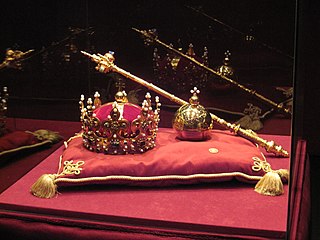
The only surviving original piece of the Polish crown jewels from the time of the Piast dynasty is the ceremonial sword Szczerbiec. It is currently on display along with other preserved royal items at the Wawel Royal Castle Museum in Kraków.

Monomakh's Cap, also called the Golden Cap, is a chief relic of the Muscovite Grand Princes and Russian Tsars. It is a symbol-crown of the Russian autocracy, and is the oldest of the crowns currently exhibited at the Imperial treasury section of the Kremlin Armoury. Monomakh's Cap is an early 14th-century gold filigree skullcap composed of eight sectors, elaborately ornamented with a scrolled gold overlay, inlaid with precious stones and pearls, and trimmed with sable. The cap is surmounted by a simple gold cross with pearls at each of the extremities.

The Royal Crown of Serbia is a royal regalia that existed during the Serbian monarchy.

The Crown of Norway is the crown of the King of Norway and was made in Stockholm in 1818 by goldsmith Olof Wihlborg. The crown is a corona clausa consisting of a ring carrying eight hoops made of gold and surmounted by a monde of blue enamel and an amethyst cross on top of it. The crown is decorated with many pearls and gemstones including amethysts, chrysoprases, a topaz and an alexandrite. Its front is adorned with a huge green tourmaline, a gift of the Brazilian consul in Stockholm to King Charles III Johan. Its splendid colours and its richly elaborated ornaments make the crown typical of the Empire period. Although the goldsmith work was carried out by Olof Wihlborg, it is not known who designed the crown.
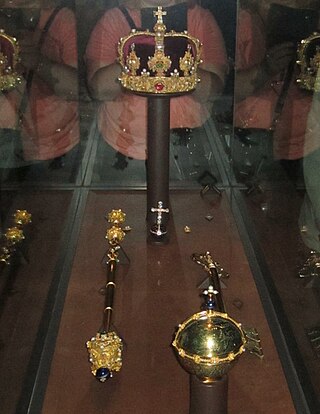
Sweden's regalia are kept deep in the vaults of the Royal Treasury, underneath the Royal Palace in Stockholm, in a museum that is open to the public. The crowns and coronets have not been worn by Swedish royalty since 1907, but they are still displayed at weddings, christenings and funerals.

The Romanov Tercentenary egg is a jewelled Easter egg made under the supervision of the Russian jeweller Peter Carl Fabergé in 1913, for Tsar Nicholas II of Russia. The Fabergé egg was presented by Nicolas II as an Easter gift to his wife, the Tsaritsa Alexandra Fyodorovna. It is currently held in the Kremlin Armoury Museum in Moscow.

The coronation of the emperor of Russia from 1547 to 1917, was a highly developed religious ceremony in which they are crowned and invested with regalia, then anointed with chrism and formally blessed by the church to commence his reign. Although rulers of Muscovy had been crowned prior to the reign of Ivan III, their coronation rituals assumed overt Byzantine overtones as the result of the influence of Ivan's wife Sophia Paleologue, and the imperial ambitions of his grandson, Ivan the Terrible. The modern coronation, introducing "Western European-style" elements, replaced the previous "crowning" ceremony and was first used for Catherine I in 1724. Since tsarist Russia claimed to be the "Third Rome" and the replacement of Byzantium as the true Christian state, the Russian rite was designed to link its rulers and prerogatives to those of the so-called "Second Rome" (Constantinople).

The Imperial Treasury at the Hofburg Palace in Vienna, Austria contains a valuable collection of secular and ecclesiastical treasures covering over a thousand years of European history. The entrance to the treasury is at the Schweizerhof, the oldest part of the palace, which was rebuilt in the sixteenth century in the Renaissance style under Holy Roman Emperor Ferdinand I. The Imperial Treasury is affiliated with the Kunsthistorisches Museum, and houses in 21 rooms a collection of rare treasures that were compiled by the Imperial House of Habsburg over the course of centuries, including the Imperial Crown, Orb, and Sceptre of Austria, and the Imperial Regalia of the Emperors and Kings of the Holy Roman Empire, including the Imperial Crown of the Holy Roman Empire.
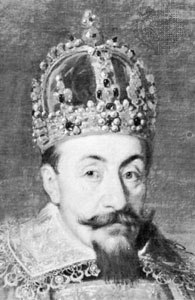
The so-called Muscovy Crown was a part of the Polish Crown Jewels. It was made in about 1610 in anticipation of Prince Władysław Vasa's coronation as Tsar of Russia, which was also known as Muscovy. Due to his father's opposition and a popular uprising in Russia, he never actually took the Russian throne, despite being elected by the Seven Boyars. Nevertheless, until 1634 he used the title of Grand Duke of Muscovy.

The Georgian Crown Jewels were the regalia and vestments worn by the monarchs of Georgia during the coronation ceremony and at other state functions. The last Georgian monarchs, Heraclius II and George XII, had their regalia invested, respectively in 1783 and 1798, from the Russian tsars, their official protectors. Of these royal jewels—a crown, sword, and scepter—only the latter staff survives, in the collection of the Kremlin Armoury in Moscow.











